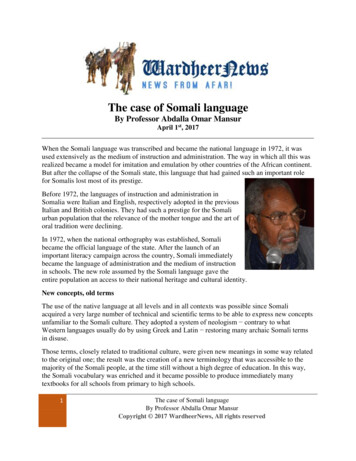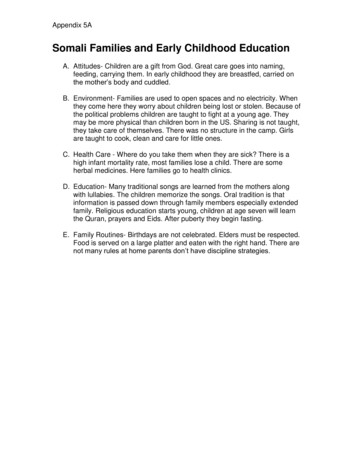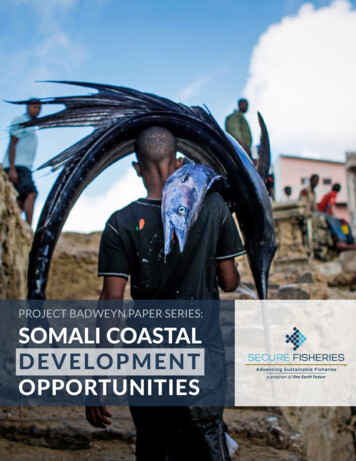
Transcription
The case of Somali languageBy Professor Abdalla Omar MansurApril 1st, 2017When the Somali language was transcribed and became the national language in 1972, it wasused extensively as the medium of instruction and administration. The way in which all this wasrealized became a model for imitation and emulation by other countries of the African continent.But after the collapse of the Somali state, this language that had gained such an important rolefor Somalis lost most of its prestige.Before 1972, the languages of instruction and administration inSomalia were Italian and English, respectively adopted in the previousItalian and British colonies. They had such a prestige for the Somaliurban population that the relevance of the mother tongue and the art oforal tradition were declining.In 1972, when the national orthography was established, Somalibecame the official language of the state. After the launch of animportant literacy campaign across the country, Somali immediatelybecame the language of administration and the medium of instructionin schools. The new role assumed by the Somali language gave theentire population an access to their national heritage and cultural identity.New concepts, old termsThe use of the native language at all levels and in all contexts was possible since Somaliacquired a very large number of technical and scientific terms to be able to express new conceptsunfamiliar to the Somali culture. They adopted a system of neologism contrary to whatWestern languages usually do by using Greek and Latin restoring many archaic Somali termsin disuse.Those terms, closely related to traditional culture, were given new meanings in some way relatedto the original one; the result was the creation of a new terminology that was accessible to themajority of the Somali people, at the time still without a high degree of education. In this way,the Somali vocabulary was enriched and it became possible to produce immediately manytextbooks for all schools from primary to high schools.1The case of Somali languageBy Professor Abdalla Omar MansurCopyright 2017 WardheerNews, All rights reserved
Furthermore, the introduction of the writing system built a bridge between the nomadic cultureand the urban one, not only because of the restoration of words and concepts belonging to thetraditional culture, but also for the fact that it became possible to create a rich written literaturedrawn from the native cultural oral heritage. So the introduction of a writing system for theSomali language facilitated the collection of a cultural heritage of great value: the Somali oralliterature such as poems, short stories, and proverbs.In this way, from 1972 until 1990, the Somalis walked on a track of modernisation and ofstandardisation of the language, achieving tangible progress. One of the comments that B.W.Andrzejewski (1977) made after 5 years Somali had become the official language of the state,was this:“ one might venture to use the term “The Somali miracle” if one considers the suddentransformation of the country from national illiteracy to a leading position in the whole Africa asfar as concerns the use of the patrial [native] language in education and public life, atransformation which has taken only five years”.He continues:“ Somali has already become, in this respect, a model for imitation and emulation by othercountries of the African continent, and several African educationalists showed great interest inher achievements at the international seminar on language and education in Africa, held inKinshasa last December. Recently a delegation from the Niger Republic visited Mogadisho todiscover what the best policy would be for the use of patrial language in schools and adulteducation”.Civil war hurt the development of languageBut what is the situation now? After the collapse of the state in 1991, the civil war havingdestroyed everything, not having saved any state structure has even damaged the path towardsdevelopment of the Somali language. As a consequence Somali is losing its important role bothat home and abroad:A. Inside the country:i) The schools which have been reactivated are teaching only in Arabic or English.ii) English is the vehicular language for administration in all fields.iii) The names of the schools, hotels, various agencies and other activities and the terminology inadvertising are foreign names or hybrid ones (Somali-English).iv) It has become common to say the numbers in English, especially phone numbers, dates, time,as if numbers did not exist in theSomali language.2The case of Somali languageBy Professor Abdalla Omar MansurCopyright 2017 WardheerNews, All rights reserved
B) Among the Somali diaspora:i) Of the thousands of Somali children outside Somalia, most do not speak Somali, some speak itbadly and just a few speak it quite well, thanks to their wise parents who value their culturalidentity and want to maintain it.ii) Adults often mix Somali with English, both in formal and informal speeches. If the adults,especially parents behave this way, what can one expect of their children?iii) The names of the Somali televisions both at home and abroad are in English, regardless thatthey broadcast only in Somali: Horn Cable TV (HCTV), Universal TV, Royal TV, SomaliNational TV (SNTV), etc.iv) Some Somalis prefer to write to their Somali friends or even in Somali newspapers in Englishrather than Somali.All these examples show that foreign languages have gained a lot of prestige among the Somalis,both inside and outside the country, while the prestige of the mother tongue is declining. Thisproves that many Somalis are losing what is called "language loyalty":“To be loyal to one's language is generally evidenced by a desire to retain an identity that isarticulated through the use of that language, and to adhere to cultural practices associated withthat language. Language loyalty leads people to work toward maintaining the language inquestion even under adverse conditions. Language maintenance consists of strategies thatgroups use to keep the language to which they are loyal alive; language persistence is theresult.” (Szecsy 2008)If one ignores his/her language, he/she is in fact losing his/her identity and this is so not only atthe individual level, but also at the national level, because the deepest feeling of identity is linkedto the sharing of a common language. In fact the Somali language is the most important cohesivefactor in our community.On one hand, there are other factors such as religion or somatic aspects that characterizeSomalis, but we also share them with others, non-Somali people. On the other hand, there arecustoms such as ways of dressing or traditional dances that are not common to all Somalis, butvary from region to region.The relevance of the native languageNow, after two decades of neglecting their own language, many Somalis are starting to realizethe importance of language and becoming sensitive to linguistic issues.In recent years some have expressed the idea that the Somali language is likely to die out. It isclear that this feeling is unfounded, but it is a sign of preoccupation, and therefore, it should beevaluated with respect. Others see that the Somali language is not stable, and they ascribe thismainly to the Somali orthography system that they consider to be incomplete.3The case of Somali languageBy Professor Abdalla Omar MansurCopyright 2017 WardheerNews, All rights reserved
With all due respect, I do not agree with them and the way they justify their protest. I do notthink that the Somali orthography is less perfect than that of the most used languages in theworld; it is very simple, without diacritics, and Somali can be written with any computer withLatin characters.Furthermore, others appear to be confused about the concept of language and dialect, which isperhaps due to the impact of the political situation in Somalia. As an example, let as see Chapterone, Article 5 of the Somali constitution that says:“Afka rasmiga ah ee Jamhuuriyadda Federaalka Soomaaliya waa Af-Soomaaliga (Maay iyoMaxaatiri), Af-Carbabiguna waa luqadda labaad.” [The official language of the FederalRepublic of Somalia is Somali (Maay and Maxaatiri), and the Arabic language is the secondlanguage]In this Article the constitution establishes that only two of the language varieties spoken inSomalia are to be considered national languages, but the modern linguistic studies, forexample Marcello Lamberti, shows that within the Somali language we can identify five groupsof dialects: Maxaatiri, Maay, Banaadir, Ashraaf and four Digil dialects(Jiiddu, Garre, Tunni, Dabarre).Maxaatiri knowns also as Northern dialects in all its varieties is spoken mainly from CentralSomalia to the North and one part of current Jubbaland area; the Maay varieties are spokenmainly in the South-West; Banaadir and Ashraaf dialects are spoken along the Southern coast;and Digil dialects are spoken in one part of South-West Somalia.Therefore, Maxaatiri and Maay are not the only two dialects spoken in Somalia.Going back to the article 5 in the Constitution, if it is intended that Maay and Maxaatiri are twodialects of Somali, then what sense does it make to mention only two if there are other dialects aswell?If it is intended that Maay and Maxaatiri are two languages, then it should be said that theofficial languages are two: the Maay language and the Maxaatiri language. In that case “theSomali language” in the Article should be removed since the Somali language, like any otherlanguage, cannot be constituted by two different languages, but only various dialects.Binary classificationsIn my opinion the confusion regarding the concepts of language and dialect is caused by twocultural factors:First, in the Somali tradition there is no concept nor a corresponding word for a dialect. Indeed,we use indifferently the word af (language) for both language and dialect: Af-Soomaali, AfMaay, Af-Garre, Af-Maxaatiri etc. Since the term dialect does not exist, we nowuse lahjad (which is Arabic) or afguri (home language) even in this case the word af (language)appears.4The case of Somali languageBy Professor Abdalla Omar MansurCopyright 2017 WardheerNews, All rights reserved
Second, according to the traditional Somali way of thinking, the Somali society is structured intwo distinctive groups, i.e. Maay and Maxaatiri speakers. Maay and Maxaatiri are the mostspoken dialects both in terms of the number of people who speak these varieties, as well as interms of the extension of geographical area.In a similar manner, the Somali tradition tends to use other binary classifications for differentsocial aspects, for example: Wadaad iyo waranle (holy man and warrior), Sab iyo Samaale (thenames of the two ancestors of all Somalis), ab’ogaa iyo abaarikeentay (indigenous andimmigrant). The same thing for the food, as the tradition says that the food is “cad iyo caano”(meat and milk).All these binary classifications are based on traditional nomadic culture and they are notsupported by contemporary context and/or modern scientific evidence: we cannot claim that theSomali society is composed only of holy men and warriors, or that the Somali food is only milkand meat. In the same way, the idea of only two Somali dialects is not correct.Standard languageA national language usually origins from a dialect spoken in a geographic area that, for variousfactors such as power, culture and religion, has managed to impose itself on other dialects orlanguages. An example of the power factor is provided by the cases of French, Spanish andEnglish, which are modeled on the language of the political and administrative capital.In France, for example, various citizens in France were forced to accept the dominance of thelanguage of Paris. Or in Ethiopia the official language is Amharic, although there are 72 otherlanguages in the same country that belong to different language families or branches.The function of the culture factor is seen in the development of Italian language. The languagespoken in Italy is originally the Florentine dialect. But Florence has never been a political centerwith super-regional ambitions. Rather, Florence was the city that gave birth to great literature.The excellence of the great Florentine writers made the Florentine dialect instrument forrecognized prestige at national level.Regarding the religion factor, examples are provided by the two best known Semitic languages,Arabic and Hebrew. Modern Arabic used today by all Arab states as an official language isderived from a dialect that was spoken at Mecca 14 centuries ago, by "Qureishits", and spreadthrough the Quran, with the inevitable changes that time has determined. Hebrew lasted over thecenturies just as a sacred language. After the Second World War, it managed to become theofficial language of the state of Israel, giving Jews, who returned from different parts of theworld, the sense of belonging to the community.Given that Maxaatiri dialects in Somalia have been used as the national language for 19 years(1972 1990), and after the state collapse people continued to use them, it is due time now toconsider them the “standard language”. Of course the two factors we mentioned above for theother languages are both relevant: the speakers of Northern Maxaatiri have always been the5The case of Somali languageBy Professor Abdalla Omar MansurCopyright 2017 WardheerNews, All rights reserved
dominant ruling class of the Somali state and many of their writers have produced a very richliterature in this variety of the language.And, as happens in the rest of the world, the other dialects must accept this sacrifice, as it is moreconvenient for a state to have a single official language. This does not mean that the otherdialects must be cancelled; indeed they can contribute to the enrichment of standard Somali, andmust be studied and described accurately.ConclusionIn order to recover its proper role, the Somali state must take care of the linguistic situation ofthe country by developing and implementing a language policy. This implies the planning ofspecific interventions with the following objectives:a) Restore the teaching of the national language – Somali as the language of instruction fromprimary to high school and reintroduce it in the administration, concretely.b) Take actions to promote the continuation of the standardization process, and the research forthe production of grammatical descriptions and of reference vocabularies (considering anddeveloping those already existing), as well as the production of adequate textbooks for theteaching of Somali.c) Help the modernization and enrichment of the vocabulary in order to meet the needs of alanguage of wider communication, and continue as in the past the expansion in the technical,scientific and administrative lexical fields.d) Promote the standardization of the language with indications and care for some degree oflinguistic purism (i.e. a limited inclusion of foreign words).Finally, it is very important that the Somali authorities give full support to Regional Academy ofthe Somali language (AGA) founded in Djibouti in 2012, for the protection of the Somalilanguage. AGA was promoted by several Somali intellectuals supported by various politicalforces of the Horn of Africa, especially the president Ismail Omar Gelle of the Republic ofDjibouti.Professor Abdalla Omar MansurEmail: amansur44@gmail.com-------------The author was Head of Italian Department of Somali National University (1980 1990). Afterthe collapse of the Somali state he has been teaching Arabic and Somali languages at theUniversità Roma Tre and he is an active member at the Centro Studi Somali (Università RomaTre). He has published and co-published several books and papers on Somali language andculture such as Qaamuuska Af Soomaaliga, co-editor Professor Annarita Puglielli, Roma 2012and Le lingue Cuscitiche e il Somalo, Studi Somali N. 8, Roma 1988.6The case of Somali languageBy Professor Abdalla Omar MansurCopyright 2017 WardheerNews, All rights reserved
Acknowledgement: I am very grateful to Professor Annarita Puglielli, with whom I havediscussed many of the issues presented in this article.BibliographyAndrzejewski, B.W. (1977). The position of Somali among the languages of the world. A lecturedelivered at the Somali Institute of Development Administration and Management, Mogadishu.Archivio Somalia.Lamberti, Marcello (1984). The Linguistic Situation in the Somali Democratic Republic, inThomas Labahn (ed): Linguistics and Literature. Proceedings of the Second InternationalCongress of Somali Studies, vol. I. University of Hamburg, August 1-6, 1983. Helmut BuskeVerlag: Hamburg, 155 200.Lamberti, Marcello (1986). Map of Somali Dialects in the Somali Democratic Republic.Hamburg: Helmut Buske Verlag.Mansur, Abdalla Omar (1998). Somali: From an Oral to a Written Language. Diogenes 46(184):91 100.Mansur, Abdalla Omar (2009). Taariikhda iyo Luqadda Bulshada Soomaaliyeed (The Historyand the Language of Somali Society). Sweden: Iftiinka Aqoonta (first edition).Mansur, Abdalla Omar (2015). Midaynta iyo Horumarinta Af Soomaaliga (Standardization andModernization of Somali Language), in Cabdirashiid M. Ismaaciil, Cabdalla C. Mansuur &Saynab A. Sharci (eds.): Afmaal (Somali Language and Literature Studies series 1). Djibouti:The Intergovernmental Academy of Somali Language, 17 35.Mansur, Abdalla Omar & Annarita Puglielli (1999). Barashada Naxwaha Af Soomaaliga (ASomali School Grammar). London: HAAN Associates.Szecsy, Elsie M. (2008). Language Loyalty, in Josué M. González (ed.): Encyclopedia of BilingualEducation. SAGE Publications.7The case of Somali languageBy Professor Abdalla Omar MansurCopyright 2017 WardheerNews, All rights reserved
In 1972, when the national orthography was established, Somali became the official language of the state. After the launch of an important literacy campaign across the country, Somali immediately became the language of administration and the medium of instruction in schools. The new role assumed by the Somali language gave the










